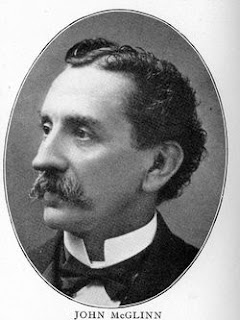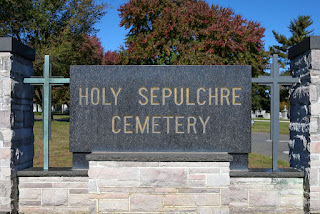 Born Joseph Geoffrion, Joseph Jefferson fled his French Canadian home as an eight-year old boy, depriving himself of an education and as an adult unable to read or write. Signing his name with an X, Joseph, shown here, became an honored Civll War soldier and co-owner of a successful Springfield, Massachusetts, liquor house, able to give his children the good education he had been denied.
Born Joseph Geoffrion, Joseph Jefferson fled his French Canadian home as an eight-year old boy, depriving himself of an education and as an adult unable to read or write. Signing his name with an X, Joseph, shown here, became an honored Civll War soldier and co-owner of a successful Springfield, Massachusetts, liquor house, able to give his children the good education he had been denied.
Joseph’s story began in February 1827 when he was born in Varennes, Quebec, the fourth of five sons of Julie Girard and Pierre Geoffrion. The boy never knew his father who died when Joseph was three. Soon after, his mother married again. The stepfather resented the boys and treated them badly. Joseph determined to run away to the United States. Although the circumstances of the escape are not clear, this act ended any prospect of Joseph receiving formal education.
 Likely with one or more brothers, the boy crossed the border as early as 1835, to Plattsburgh, New York, and changed his name to Jefferson, just a short stretch from “Geoffrion.” His early years are lost in the mists of history, but we know he never went to school. Joseph comes to the public record in October 1845 in Plattsburgh when he married Adeline Venet in the Presbyterian Church. Eight years later, after having three children, they repeated their vows in St. Peter’s Catholic Church, above. Descendants have assumed that Joseph converted to Catholicism. My guess is that as a French Canadian, he had been one from birth and was returning to the faith.
Likely with one or more brothers, the boy crossed the border as early as 1835, to Plattsburgh, New York, and changed his name to Jefferson, just a short stretch from “Geoffrion.” His early years are lost in the mists of history, but we know he never went to school. Joseph comes to the public record in October 1845 in Plattsburgh when he married Adeline Venet in the Presbyterian Church. Eight years later, after having three children, they repeated their vows in St. Peter’s Catholic Church, above. Descendants have assumed that Joseph converted to Catholicism. My guess is that as a French Canadian, he had been one from birth and was returning to the faith.
Joseph and Adeline would have seven children between 1847 and 1862, four boys and three girls. Sadly, one would die in infancy and two others succumbed before reaching maturity. Between 1858 and 1860 the family relocated to Chicopee, Massachusetts, where they opened a boarding house and accommodated eight residents. Several years later the family pulled up stakes again and moved to Springfield, just four miles down the road. Shown below, it would be their permanent home.
With the onset of the Civil War, Joseph’s age (37) and illiteracy did not prevent his enlisting in the Union Army in August 1864. In his earlier years he apparently had developed skills as a “moulder,” a skilled craftsman accustomed to shaping metal objects, i.e. cannon balls. He was inducted as a private in the 30th Massachusetts Unattached Heavy Artillery Regiment and sent to help garrison Washington , D.C.
In July 1864 Lieutenant General Jubal A. Early had led 14,000 Confederate troops across the Potomac River into Maryland and then circled around to attack the Union capital from the north in what became known as the Battle of Fort Stevens. Early and his men made a few probing runs at the fort, but quickly realized that even with their superior numbers, victory was impossible. By the time Joseph arrived on the scene, however, any serious threat to the Nation’s Capitol was over. He served for the remaining months of the Civil War and was discharged in June 1865. In 1891, the 64-year old veteran would be awarded his Civil War pension.
 Shortly after Joseph returned to Springfield, Adeline died, leaving him with a household of minor children. Perhaps seeking a mother for his brood, he soon married Euphemia Anna Woods, shown here in middle age. Thirteen years younger than Joseph, Euphemia was born in Quebec of French-Canadian parentage. She came to the U.S, in the late 1850s as a skilled weaver and worked in the mills of Ware, Mass. It was her first marriage. Together they had four children between 1871 and 1880, two daughters and two sons, bringing Joseph’s total progeny to eleven. Called “Phebe,” a family biographer said of Euphemia: “She worked diligently raising her children, keeping house and running a boarding house.”
Shortly after Joseph returned to Springfield, Adeline died, leaving him with a household of minor children. Perhaps seeking a mother for his brood, he soon married Euphemia Anna Woods, shown here in middle age. Thirteen years younger than Joseph, Euphemia was born in Quebec of French-Canadian parentage. She came to the U.S, in the late 1850s as a skilled weaver and worked in the mills of Ware, Mass. It was her first marriage. Together they had four children between 1871 and 1880, two daughters and two sons, bringing Joseph’s total progeny to eleven. Called “Phebe,” a family biographer said of Euphemia: “She worked diligently raising her children, keeping house and running a boarding house.”
By this time Joseph had determined that a more profitable life style lay in selling liquor. After an initial location at 45 Railroad Street, Joseph moved his saloon to larger quarters at 189 Main Street. He and his family and their boarders resided above the business. By 1890, the saloon/boarding house had moved once again, this time to 67 Water Street. The residence now was called Jefferson House and a wholesale liquor business had been added to the saloon. Subsequently called Jefferson & Sons, by 1894 the family enterprises moved once again to 10-12 Bridge Street. The sons involved were Charles and Albert from Joseph’s first marriage, now grown to maturity.
 About 1896 the business was renamed once again, becoming Jefferson & Sons Restaurant and Saloon. Having shucked themselves of the boarding house, Joseph and Euphemia for the first time in their married life were able to live apart from their business. Their home, shown here, a large three story residence located at 37 Palmer Avenue was large enough to accommodate them and the families of two daughters. As they aged, it meant that the couple was surrounded by grandchildren.
About 1896 the business was renamed once again, becoming Jefferson & Sons Restaurant and Saloon. Having shucked themselves of the boarding house, Joseph and Euphemia for the first time in their married life were able to live apart from their business. Their home, shown here, a large three story residence located at 37 Palmer Avenue was large enough to accommodate them and the families of two daughters. As they aged, it meant that the couple was surrounded by grandchildren.
For the next few years, Joseph continued to guide the fortunes of Jefferson & Sons, adding cigars, tobacco, billiards and pool to the food and drink available at Jefferson & Sons. By 1910, Joseph had retired and his son Charles took over the liquor dealership, closing the saloon, restaurant and pool hall. The company became Jefferson & Deely Wholesale Liquors. This new partner was John J. Deely, a local businessman. In a final move their establishment was relocated at 192 Worthington Street in Springfield.
 The liquor enterprise featured two house brands, “Westbrook,” a whiskey, and “Worthington,” liquor that came as both bourbon and rye. Neither brand appears to have been trademarked by the Jeffersons. Shown above is the colorful label of Westbook, depicting a man with a long pole fishing in a picturesque mountain stream. For their Worthington brand the partners issued shot glasses to customers at the saloons, hotels, and restaurants of Springfield and environs.
The liquor enterprise featured two house brands, “Westbrook,” a whiskey, and “Worthington,” liquor that came as both bourbon and rye. Neither brand appears to have been trademarked by the Jeffersons. Shown above is the colorful label of Westbook, depicting a man with a long pole fishing in a picturesque mountain stream. For their Worthington brand the partners issued shot glasses to customers at the saloons, hotels, and restaurants of Springfield and environs.

Now retired and residing amid the family he had been denied as a child, Joseph lived to be 86 years old. Honored as a Civil war veteran and the patriarch of the Jeffersons, after a five week illness, he died on April 7, 1913 and was buried at Saint Benedict’s Cemetery, Springfield, next to his first wife, Adeline. Euphemia would join them there four years later. Shown below is their joint tombstone. The other side of the stone records the earlier deaths of six of the Jefferson children, each one a source of family grief.
A fitting summation to the life of this extraordinary man has been provided by an anonymous descendant: “Joseph Jefferson left his home at a tender age, depriving himself of his intended religion, his inheritance and any education. This proud Civil War Veteran, foundry worker, moulder and businessman worked hard, lived a long life yet he signed his name with an X. His children by both marriages were given the benefits of public schools and advanced learning denied the 8-year-old boy who ran away and crossed the border to a better life in Plattsburgh and beyond.” To this I can only add: “May he rest in peace.”
Note: This post would not have been possible without a detailed biography found on the Internet seemingly written by an anonymous descendant. I am hopeful that a knowledgeable person will see this vignette and let me know the source so that adequate credit can be given.





































